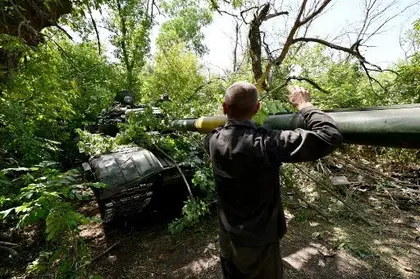Russian Federation (RF) ground attacks across the Ukraine’s 2,000-plus kilometer fighting front were at a near total halt on Wednesday, July 13, as Ukrainian precision-guided munitions blasted another Kremlin-controlled ammunition depot, this time in the occupied city of Luhansk.
Multiple information sources from both sides of the war, including the pro-Russia Readovka news platform and Ukraine’s Army General Staff (AGS), on July 13 said combat movement over the past 24 hours had practically ceased, but artillery exchanges were continuing.
“Our troops took a tactical pause to pull up material resources and regroup troops,” Moscow-controlled Readovka reporters. “However, this did not make it any less work for the Ukrainian side – continuous and harassing fire is being conducted on Armed Forces of Ukraine (UAF) positions across the entire sector of the front.”
RF forces attempted a limited reconnaissance-in-force in the Zaporizhzhia sector, and were repelled with losses near the villages of Dovhenkiy and Dolyna, a statement from the Zaporizhzhia regional defense command said. Overall, RF units were digging in across the southern front, and improving defenses, and not even attempting to advance, the morning AGS situation report said on the morning of Wednesday, July 13.
Serhiy Haidai, head of the Luhansk regional defense command, in a July 12 evening statement said that RF artillery fires had fallen off in intensity in recent days due to dozens of UAF long-range strikes against Kremlin-controlled ammunition dumps.

Drone Wars –Technology, Tactics, Strategy, Countermeasures, Legislation
“The occupying [Russian] army has not stopped shelling, but, most likely, they are saving their supplies. Their deliveries (of more ammunition) has been interrupted by the work of the APU,” Haidai said.
UAF troops using primarily long-range artillery rockets fired from US-manufactured HIMARS and M270 systems have demolished at least 20 RF ammunition depots since July 1, along with unit headquarters and logistics hubs.
On the evening of Tuesday, July 12 the RF-occupied city of Luhansk became the latest target in the UAF ammo dump campaign, with at least six Ukrainian long-range artillery rockets hitting a storage site in the city center. Local news reports and a flood of social media images showed massive orange fireballs as the weapons struck, followed by dozens of secondary explosions.
Andrei Morochenko, a spokesman for the Kremlin-controlled Luhansk People’s Republic (LPR), told the Moscow-controlled news agency RIA Novosti the UAF were fired rockets from a range of 140 to 300 kilometers to hit an anti-aircraft unit based in the city. He claimed RF air defenses in Luhansk were still operational.
According to news reports and Ukrainian military intelligence, the RF military has deployed a dense mix of anti-aircraft systems around key sites like Luhansk. Some of those systems, particularly Russia’s S-300 and S-400 anti-aircraft missiles, were designed to intercept incoming artillery rockets.
A Tuesday HIMARS strike against the RF-occupied town of Nova Khakovka likewise seemed to undermine claims of those systems’ effectiveness, with a six rocket UAF salvo not only hitting targets, but demolishing an RF anti-aircraft system placed there specifically to provide defense against incoming rockets, news reports from both independent Ukrainian and RF-controlled media said.
Mykhaylo Podolyak, an adviser to the Presidential Administration, in a Monday, July 11 statement argued that Moscow has grossly oversold the capacity of its top-of-the-line S-400 anti-aircraft system. The Kremlin has touted the S-400 as the world’s most effective anti-aircraft system, and fully capable of tracking and destroying practically any flying object within hundreds of kilometers – including artillery rockets.
Kremlin advertising notwithstanding, UAF forces using HIMARS rockets are picking off S-400 systems one by one, Podolyak claimed during a press conference, using a sports reference to the RF’s historically poorly-performing national soccer team.
“Russia wants to show that she has powerful weapons superior to anything else in the world. You all [independent media] have seen that the famous S-400 system intercepts rockets, like the Russian national soccer team catches soccer balls,” Podolyak said in part.
You can also highlight the text and press Ctrl + Enter






